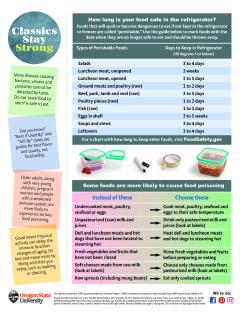Focus on Food Safety
Protect yourself and others from food poisoning by following these 4 food safety steps
- Clean: Wash hands, utensils and kitchen surfaces often when preparing food.
- Separate: Keep raw meat, poultry and seafood away from other foods.
- Cook: Cook food to a safe temperature to kill harmful microorganisms.
- Chill: Refrigerate leftovers and foods that spoil within 2 hours.
Everyday tips for safe food
- Rinse fresh fruits and vegetables under running water before preparing, unless they are pre-rinsed or cut for ready-to-eat.
- Raw chicken should not be rinsed first. Rinsing can spread germs to other foods, the sink and the counter.
- Use a food thermometer to check if a food has reached a safe internal temperature.
- Label leftovers with the date to be thrown away if not yet eaten. For many items, this is three to four days after they are prepared.
- Thaw frozen foods in the refrigerator. Place in a container on a low shelf where they won't drip on other foods.
USDA Recommended Safe Minimum Internal Temperatures
- Steaks and Roasts: 145 degrees F
- Fish: 145 degrees F
- Pork: 160 degrees F
- Ground Beef: 160 degrees F
- Egg Dishes: 160 degrees F
- Chicken Breasts: 165 degrees F
- Whole Poultry: 165 degrees F
- Frozen Foods and Leftovers: 165 degrees F
Classics Stay Strong
- Many disease-causing bacteria, viruses and parasites cannot be detected by taste. Do not taste food to see if is safe to eat.
- Did you know? “Best if Used By” and “Sell By” dates are guides for best flavor and quality, not food safety.
- Older adults, along with very young children, pregnant women and people with a weakened immune system, are more likely to experience serious food poisoning.
- Good news! Physical activity can delay the immune function changes of aging. Sit less and move more by doing activities you enjoy, such as walking or dancing.
How long is your food safe in the refrigerator?
Foods that will spoil or become dangerous to eat if not kept in the refrigerator or freezer are called "perishable." Use the guide below to mark foods with the date when they are no longer safe to eat and should be thrown away.
Types of Perishable Foods and Days to Keep in the Refrigerator at 40 degrees F or below
- Salads: 3 to 4 days
- Luncheon meat, unopened: 2 weeks

- Luncheon meat, opened: 3 to 5 days
- Ground meats and poultry (raw): 1 to 2 days
- Beef, pork, lamb and veal (raw): 3 to 5 days
- Poultry pieces (raw): 1 to 2 days
- Fish (raw): 1 to 3 days
- Eggs in shell: 3 to 5 weeks
- Soups and stews: 3 to 4 days
- Leftovers: 3 to 4 days
- For a chart with how long to keep other foods, visit FoodSafety.gov
Some foods are more likely to cause food poisoning, but you can make a safe choice
- Instead of choosing undercooked meat, poultry, seafood or eggs, cook those foods to their safe temperature.
- Instead of unpasteurized or raw milk and juices, drink only pasteurized milk and juices. Look at product labels to be sure.
- Instead of deli and luncheon meats and hot dogs that have not been heated to steaming hot, cook those items until they are steaming hot.
- Instead of fresh vegetables and fruits that have not been rinsed, do rinse those items before preparing or eating.
- Instead of soft cheeses made from raw milk, choose only cheeses made from pasteurized milk. Look at product labels to be sure.
- Instead of eating raw sprouts, including mung bean sprouts, choose to eat only cooked sprouts.




